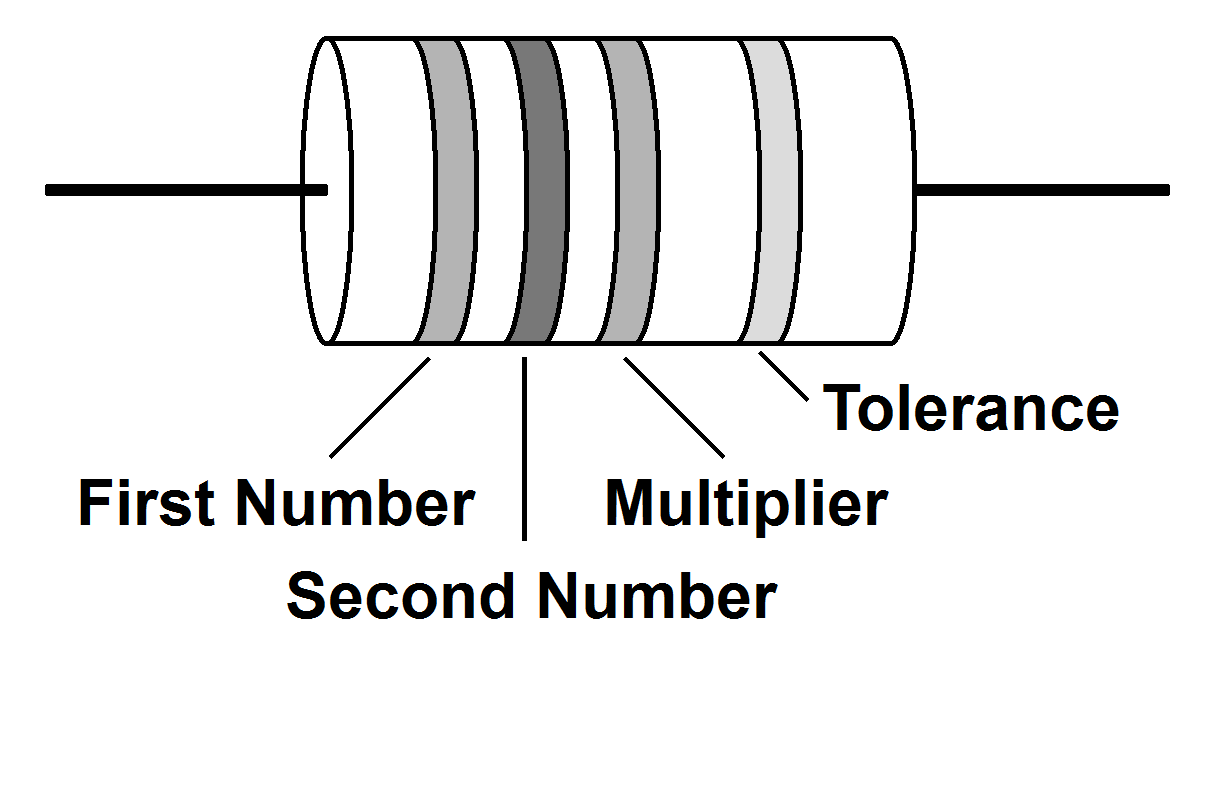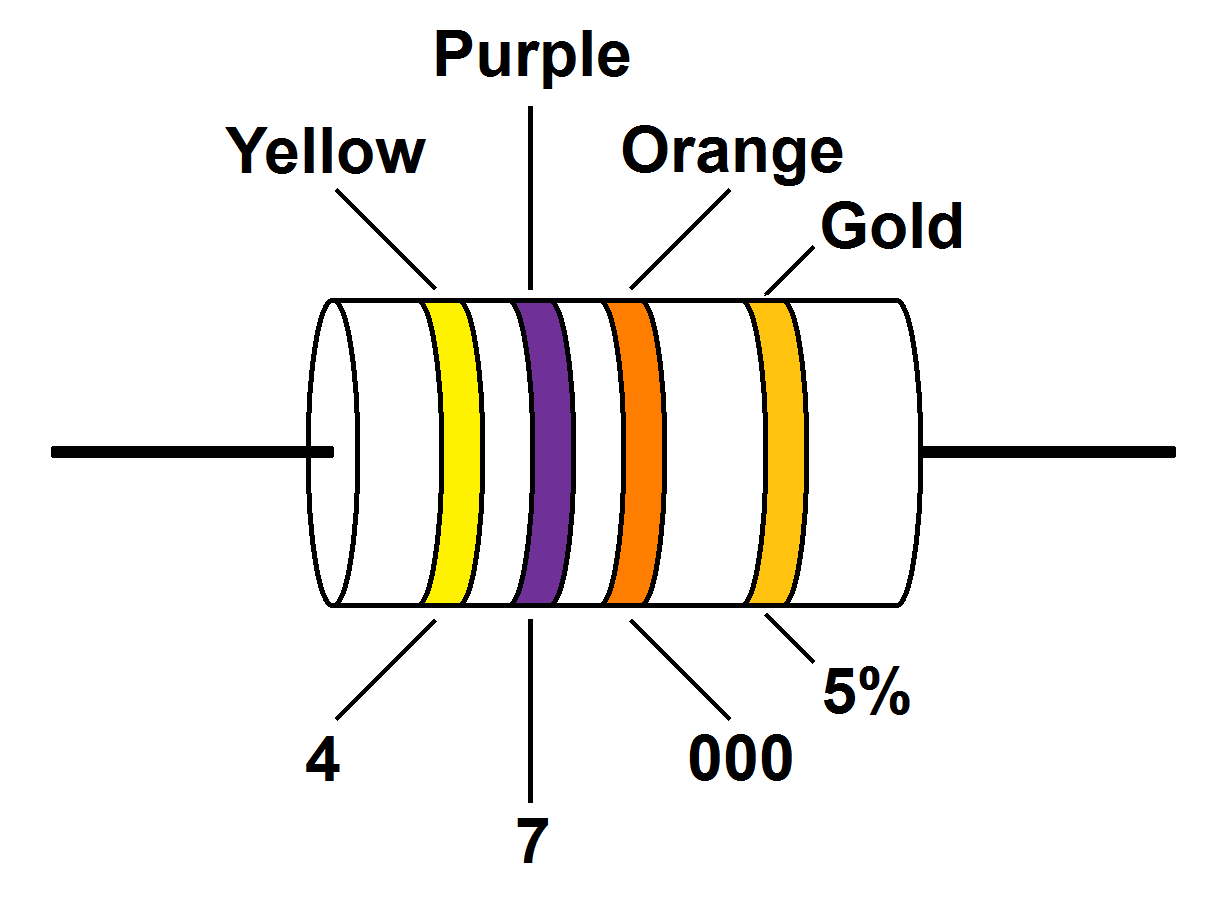| Vocademy |
The Resistor Color Code
Most resistors are labeled using
colored bands painted on the resistor. You should be able to read the color code as well as calculate
whether a
resistor is within tolerance. Here is the color code and how to
decipher it.
| The Resistor Color Code | |
| 0 = Black | 5 = Green |
| 1 = Brown | 6 = Blue |
| 2 = Red | 7 = Purple |
| 3 = Orange | 8 = Grey |
| 4 = Yellow | 9 = White |
One acronym used to help remember the
color code is Better Be Ready Or
Your Great Big Plan Goes Wrong, as shown below.
| Better | Be | Ready | Or | Your | Great | Big | Plan | Goes | Wrong |
| Black | Brown | Red | Orange | Yellow | Green | Blue | Purple | Grey | White |
| 0 | 1 | 2 | 3 | 4 | 5 | 6 | 7 | 8 | 9 |
The following diagram shows how the
colors are used. The first two
bands are values of resistance and the third band is a multiplier.
 |
 |
|
The Colors on a
Resistor |
|
Essentially a resistor is read as:
first number, second number, number
of zeros. For example, if the colors are yellow-purple-red, the numbers
are 4-7-2. This reads 4, 7 and two zeros or 4,700 ohms. If the colors
are brown-black-orange, the numbers are 1-0-3. This reads 1, 0 and
three more zeros or 10,000 ohms. If the colors are green-red-black, the
numbers are 5-2-0. This reads 5, 2 and no zeros or 52 ohms. If the
third band is gold or silver, the resistor has a value of less than 10
ohms. Gold denotes a multiplier of 0.1 and silver denotes a multiplier
of 0.01. For example, if the colors are brown-black-gold, the numbers
are 1-0-1/10. This reads 1, 0, then divide by 10 for 1 ohm.
Brown-black-silver would be 0.1 ohm. A single black band is 0 ohms. This is
merely a shorting wire or jumper that looks like a resistor.
Exercise: decode the following colors1
|
red-black-orange = __________ ohms |
orange-red-brown = __________ ohms |
|
brown-red-red = __________ ohms |
purple-green-black = __________
ohms |
|
blue-white-yellow = __________
ohms |
yellow-purple-gold = __________ ohms |
Precision resistors have four colors
bands instead of three (excluding
the tolerance band). These resistors are read: first number, second
number, third number, number of zeros. For example, a 10,000-ohm
resistor would normally be marked brown-black-orange. A precision
10,000-ohm resistor would be marked brown-black-black-red.
Exercise: decode the following colors for precision resistors1
|
red-black-black-red = __________
ohms |
orange-red-black-black =
__________ ohms |
|
brown-red-black-black =
__________ ohms |
purple-green-black-gold =
__________
ohms |
|
blue-white-black-orange =
__________
ohms |
yellow-purple-black-silver =
__________ ohms |
Calculating tolerance
The tolerance band will be either
silver or gold. Silver is 10% tolerance and gold is 5% tolerance. If
there is no fourth band, the tolerance is 20%.
To calculate resistor tolerance limits, follow this procedure:
To calculate resistor tolerance limits, follow this procedure:
- Multiply the specified resistance by the tolerance.
- Add this product to the specified resistance. This gives you the highest allowed value.
- Subtract the product from the specified resistance. This gives you the lowest allowed value.
For example, if you have a resistor
that is colored Yellow-Purple-Orange-Gold, the resistor is 47,000 ohms
with a 5% tolerance. Calculate the allowed range of resistance like
this:
|
|
1.
|
47,000 X .05 = 2,350 |
|
|
2. | 47,000 + 2,350 = 49,350 – this is the highest allowed value |
|
|
3. |
47,000 - 2,350 = 44,650 – this is the lowest allowed value |
This 47,000-ohm resistor may have a
resistance that ranges from 44,650 ohms to 49,350 ohms and still be
within the specified tolerance.
Exercise: which of the following values is within the tolerance of an Orange-Orange-Orange-Gold resistor?2
a. 34,720 b. 32,770 c. 34,670 d. 31,330
A resistor with four color bands (where the fourth band is neither silver nor gold) has a tolerance of 1%. A 1% resistor may also have a fifth band that is brown. The following table shows the tolerance colors (fifth band) for precision resistors.
Exercise: which of the following values is within the tolerance of an Orange-Orange-Orange-Gold resistor?2
a. 34,720 b. 32,770 c. 34,670 d. 31,330
A resistor with four color bands (where the fourth band is neither silver nor gold) has a tolerance of 1%. A 1% resistor may also have a fifth band that is brown. The following table shows the tolerance colors (fifth band) for precision resistors.
| Tolerance Codes for Precision Resistors | |
| 1% = Brown or none | .25% = Blue |
| 2% = Red | .1% = Purple |
| .5% = Green | .05% = Grey |
Power rating
Power will be discussed below after
Ohm's Law. However, since power is produced when current flows through
a resistor, resistors are rated for how much power they can dissipate
safely. Since power produced in resistors is manifested as heat, and
larger resistors can dissipate more heat than smaller resistors, the
size of a resistor is a direct product of its power capacity.
There is no set size scale for rating power capacity of resistors, but typical resistors (about 3/32 inch diameter and 5/16 inch long) have a power capacity of 1/4 watt. A 1/2 watt resistor is notably larger and a 1/8 watt resistor is notably smaller. High-power resistors may have metal cases with heat dissipating fins and be designed to be mounted on heat sinks.
There is no set size scale for rating power capacity of resistors, but typical resistors (about 3/32 inch diameter and 5/16 inch long) have a power capacity of 1/4 watt. A 1/2 watt resistor is notably larger and a 1/8 watt resistor is notably smaller. High-power resistors may have metal cases with heat dissipating fins and be designed to be mounted on heat sinks.
| 1 |
20,000 (20k)
| 320 1,200 (1.2k) | 75 690,000 (690 k) | 4.7 The precision resistors are the same answers |
|
2 |
b. 32,770 ohms |
The Resistor Color Code
| Vocademy |